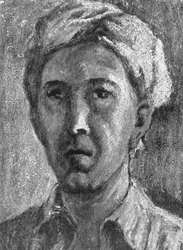KLEIN, József
(1896, Csermő - 1945, Auschwitz?)


The place that József Klein occupied in the small society of the artist colony was defined by his education, his multilateral knowledge, his immediate response to the modern creation of forms and his social sensibility. Due to what he experienced in Paris, his works represented modern art and spiritual renewal beginning with the twenties. His instruction and example encouraged the youth and nursed the avant-garde movement that was developing at the colony.
After finishing high school at Arad, he attended the University of Fine Arts in Budapest between 1916 and 1919. He worked with Vilmos Perlrott Csaba at the Kecskemét art colony in 1919. He settled in Nagybánya in 1920. He never took under a civil job. He earned his living by selling his pictures and was helped out by his wife, who was designing hats.
His art can be divided into an earlier naturalistic phase and one avant-garde period that came after his stay in Paris. He spent more than one and a half-year working in Paris between 1925 and 1927. He was one of those few people at the colony, who had direct access to the modern results of European art. He was inspired by the art of Foujita, Chagall, Utrillo, Picasso and Puvis de Chavannes. When he returned, he organized individual exhibitions in Nagybánya, Kolozsvár, Bukarest and Temesvár. He made essential use of the results of expressionism, constructivism and neoclassicism. Besides his paintings his graphical work is very significant also. He prepared drawings, water-colours, coloured lino-engravings. He presented these works on individual and group exhibitions as well. His artistical oeuvre represents a kind of modernism that was reached only by the most significant masters, Sándor Ziffer and Noémi Ferenczy. He creates real masterpieces in the name of this up-to-dateness and modernity. Therefore, it is no coincidence that the young artists chose him to be their mentor. His disciples made a great use of his theoretical knowledge and his practical advice.
József Klein lived in Bucharest between 1932 and 1937 and worked in the field of applied arts. In the late thirties he finished some greater scaled paintings (Spring, Summer, Autumn, Winter) that were meant to be frescoes at the beginning. He returned to Nagybánya in 1938 and organized an exhibition together with Jenő Szervátiusz.
He presented his anti-fascist caricatures to the circle of his closest friends in 1943, on new year's eve. Together with other Jews from Nagybánya, the painter and his wife (Piri Kohn) were deported in the June of 1944. He died either in Auschwitz or the KZ camp near Melk an der Donau. A memorial exhibition was organized for him in the museum of Nagybánya in 1962.
